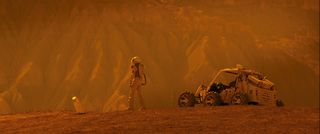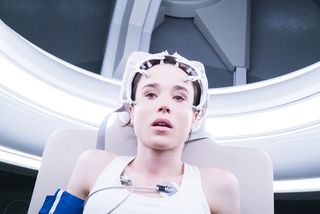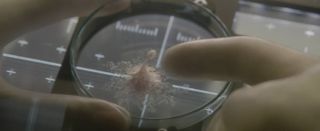Science and Sci-Fi at the Movies in 2017
Some films presented the stories of real people whose historic contributions to modern science were long hidden from public view. Others were set in a world and time much like the present one, but with some type of science fiction twist, while still others spun futuristic and fantastic tales of imaginary universes occupied by bizarre and unfamiliar creatures wielding technologies that we can only dream of.
From Space.com and Live Science, here's our roundup — in no particular order — of science and sci-fi at the movies in 2017.
Hidden Figures

Not only did "Hidden Figures" (20th Century Fox) do a great job of showing how NASA launched its first astronaut into orbit during the space race, but it also tells the important story of the role that African-American women played in helping NASA achieve that goal at a time when the agency and the rest of the nation was still highly segregated.
The Girl with All the Gifts

What if a type of fungus that parasitized and mind-controlled ants were to infest people? In "The Girl with All the Gifts" (Saban Films/Lionsgate), the world is transformed by a type off fungal parasite that acts on humans like the fungus Ophiocordyceps acts on ants, hijacking their brains and bodies and changing their behavior. But unlike Ophiocordyceps, the fungus in the film turns its hosts into vicious, flesh-eating zombies.
King Kong

On an isolated island paradise, a team of adventurers, researchers and military personnel unite to battle deadly creatures — including a giant ape that stands about 100 feet tall, the length of a modern blue whale. No land mammal has ever reached that height, though some types of sauropod dinosaurs once achieved Kong-like stature, and the largest mammals to walk the Earth went extinct by the end of the last ice age. Kong may be big, but even bigger threats awaited voyagers to this mysterious island.
Valerian and the City of a Thousand Planets

Based on the French comic series "Valérian and Laureline," this movie chronicles the adventures of two government agents who are tasked with maintaining order in the universe and fall in love in the process. While the love story itself is less than stellar, the movie is loaded with gorgeous extraterrestrial creatures, strange alien planets and action-packed scenes that will keep you on the edge of your seat. And there's plenty of science too.
The Space Between Us

In this cosmic coming-of-age story, the first human born and raised on Mars decides to visit Earth to find his father and a girl he met online. But when he reaches Earth, his body proves ill-equipped to handle the increased gravity in this new environment. He ends up racing accomplish his mission before his body breaks down — and evading the authorities who are trying to save his life. "The Space Between Us" (STXfilms) may be a fictional love story, but the science behind the film is based on real science facts and up-to-date research on spaceflight and the human body.
Sign up for the Live Science daily newsletter now
Get the world’s most fascinating discoveries delivered straight to your inbox.
The Immortal Life of Henrietta Lacks

This original HBO film "The Immortal Life of Henrietta Lacks" based on the book by journalist Rebecca Skloot, tells the story of Henrietta Lacks, an African-American woman who died of cancer in 1951, and whose cells from a malignant tumor created a cell lineage that seemed "immortal," the first survive and reproduce in the lab. Unbeknownst to Lacks' family, her cells were widely distributed for use in scientific research, and the movie follows Lacks' daughter Deborah (Oprah Winfrey) as she searches for answers about her mother's death and uncovers what happened to her cells after she died.
Flatliners

Dallying with death can come at a terrible cost, as five medical students find out in the movie "Flatliners" (Sony Pictures). Ambition and curiosity drive them to experience "the afterlife" by deliberately stopping their hearts, and they soon learn that dying — even temporarily — comes with unexpected and terrible consequences. But not everything they experience after their brief "deaths" occupies the realm of science fiction, as a growing body of research suggests that human consciousness doesn't immediately wink out after the heart stops.
Life

When astronauts at the International Space Station (ISS) discover the first Martian lifeform following a robotic sample-return mission to the Red Planet, humanity welcomes the discovery with open arms. But the adorable alien specimen, which looks like a squirmy li\le mushroom, quickly kills the mood as it grows out of control and embarks on a murderous rampage. The astronauts make some questionable decisions while fighting for their lives as the Martian monster destroys everything around them. While the film brings to attention the ethics of meddling with extraterrestrial life, it also illustrates precisely what not to do during an alien attack at the ISS.
Blade Runner 2049

It took 35 years for fans of the 1982 sci-fi noir classic "Blade Runner" to finally get their sequel, which takes place 30 years after the events of the first film. And a new "Blade Runner" movie means more replicants — the androids that are nearly impossible to distinguish from people, except by highly trained professional assassins. Replicant-hunter Officer K (Ryan Gosling) digs deep to find answers about these humanlike machines — which are still a long way off for the rest of us.
Alien: Covenant

The latest installment in the "Alien" movie saga delivers all the blood, guts and extraterrestrial terror that fans of the original movies would expect. A spaceship carrying 2,000 space colonists to their new home planet changes course after the crew receives a rogue transmission that sounds like it came from a human in distress. Before long, terrifying xenomorphs start bursting out of people's chests and making the crew the USCSS Covenant regret pursuing this brave rescue mission.
The Shape of Water

The poetic movie "The Shape of Water" (Fox Searchlight Pictures) introduces a mysterious creature that appears to be part human and part fish. While the movieis set against the backdrop of the Cold War, the unusual creatureis like nothing ever seen on Earth — asemiaquatichumanoid biped that is also adapted for life in water. Housed in a secret government lab, he is prodded, poked and probed by scientists until a deaf woman who works in the building befriends him, and plots to rescue him from his captors.
Star Wars: The Last Jedi

One of the most highly anticipated science-fiction movies of the year, "Star Wars: The Last Jedi" (Walt Disney Studios) does not disappoint. The eighth installment in the iconic space opera is emotional and gripping, and it addresses some of the biggest mysteries viewers were left with after watching "The Force Awakens." The show is visually stunning, with epic space battles and outrageously adorable porgs.
Original article on Live Science.

Hanneke Weitering is an editor at Liv Science's sister site Space.com with 10 years of experience in science journalism. She has previously written for Scholastic Classroom Magazines, MedPage Today and The Joint Institute for Computational Sciences at Oak Ridge National Laboratory. After studying physics at the University of Tennessee in her hometown of Knoxville, she earned her graduate degree in Science, Health and Environmental Reporting (SHERP) from New York University. Hanneke joined the Space.com team in 2016 as a staff writer and producer, covering topics including spaceflight and astronomy.
